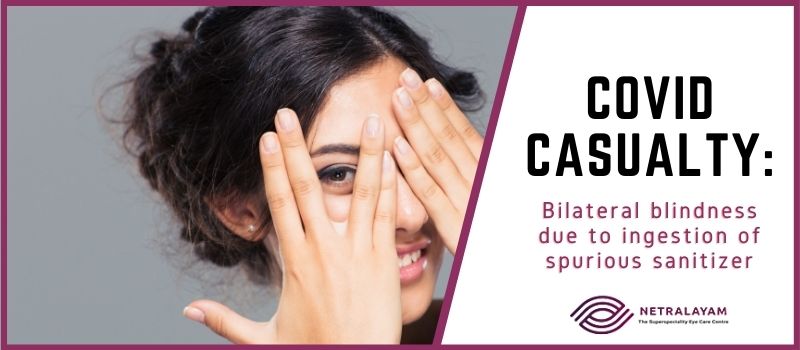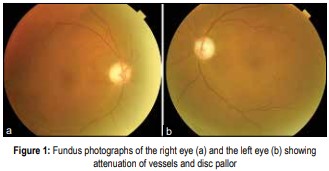Committed to Eye Care with Compassion, Technology and Competency
Committed to Eye Care with Compassion, Technology and Competency

11/3/2020
Intentional ingestion of alcohol‑based handrub (ABHR) or sanitizer solution is uncommon. The coronavirus disease‑19 pandemic caused by severe acute respiratory syndrome coronavirus 2 has led to lockdowns being put in place in many countries across the globe and resulted in a surge in ABHR usage to maintain hand hygiene. In this communication, we report the case of a 56‑year‑old male, a chronic alcoholic who presented during the lockdown period, with acute bilateral loss of vision following ingestion of ABHR. The handrub was found to be a nonstandardized sanitizer with no labels mentioning its constituents. Typically, the ingestion of ABHR solutions results in isopropanol or ethanol poisoning, both of which have low toxicity. Based on the clinical history and findings in our patient, a diagnosis of optic neuropathy due to accidental ingestion of sanitizer containing methyl alcohol as an unlisted ingredient was made. Our report underscores the need for strict guidelines, toxicovigilance, and surveillance systems to be in place to prevent such adulterated ABHRs from being commercially available.
The coronavirus disease (COVID‑19) pandemic has led to many changes in social practices across all walks of life including the practice of medicine. A combination of hand hygiene and face mask is known to be effective in reducing transmission of respiratory illnesses including COVID‑19. Alcohol‑based handrubs (ABHRs) or sanitizers are widely available and preferred for their effectiveness in ensuring antisepsis, while causing less skin irritation and requiring less time for application.[1,2] ABHRs usually contain ethyl alcohol, isopropyl alcohol, n‑propyl alcohol, or combinations of these. While exact formulations vary depending on the manufacturer, ABHRs typically contain 60%–95% alcohol by volume. Additional inactive ingredients in sanitizers may include acetone, 1‑propyl alcohol, 2‑propyl alcohol, benzyl alcohol, hydrogen peroxide, glycerin, and water.[3,4] It has been reported that patients with disorders of alcohol abuse, have, on multiple occasions intentionally ingested ABHRs.[5,6] Rarely, methyl alcohol has been found to be an unlisted ingredient in sanitizers, which if consumed – either accidentally or intentionally, can lead to drastic consequences.[2] In this communication, we highlight one such case of a patient who suffered from alcoholism, who following intentional ingestion of sanitizer containing methyl alcohol, developed bilateral irreversible blindness.
A 56‑year‑old‑male presented with a 20‑day‑old history of sudden, painless loss of vision in both eyes. There was no history of trauma or recent surgery. On ocular examination, he denied perception of light in both eyes; the pupils were mid‑dilated and nonreactive. Anterior segment findings were unremarkable and intraocular pressures in both eyes were normal. On dilated fundus examination, the optic discs were pale; no optic disc edema was noted; the macula and peripheral retina were normal in both eyes [Figure 1a, 1b]. 
Systemically, he suffered from chronic alcoholism and family members mentioned that they observed a heightened state of anxiety and restlessness for many days before the vision loss. They presumed that this was because he was unable to procure and consume alcohol due to the nationwide lockdown. On questioning, the patient disclosed that 1 day before the vision loss, he had ingested one small bottle of locally procured ABHR (approximately 60 mL). The following morning, the patient noticed the decrease in vision which rapidly progressed to complete loss of perception of light within 24 h.
Optical coherence tomography of the optic disc showed thinning of the retinal nerve fiber layer in both eyes. Visual evoked potentials (VEP) were nearly extinguished in both eyes. Magnetic resonance imaging of the brain and orbit brain done immediately following vision loss showed multiple white matter hyperintensities lesions on T2 and fluid‑attenuated inversion recover mainly in the frontoparietal region. Bilateral cerebellar abnormalities with areas of restricted diffusion with no significant enhancement postcontrast were also noted, which presented a picture, consistent with toxic encephalopathy. The ABHR bottle was inspected and found to have no labeling indicating its constituents or any toxicological warnings. Basic hematological investigations and serum Vitamin B12 level were normal. Based on the clinical picture, radiological findings, and abnormal VEP, a diagnosis of methanol toxicity leading to bilateral optic atrophy was made. The patient was referred to the neuropsychiatric division for counseling and treatment.
Most ABHRs contain ethanol, isopropyl alcohol, n‑propyl alcohol, or their combinations. Cases of toxicity due to the ingestion of ABHRs containing isopropyl alcohol and ethyl alcohol have been separately reported in the literature.[5‑7] Table 1 shows the list of agents known to cause toxic optic neuropathy. Ingestion of such ABHRs can lead to serious complications such as depression of the central nervous system and myocardial function. Between 2011 and 2014, a total of 70,669 hand sanitizer exposures in children aged 12 years or younger were reported in the United States.[8] This includes 65,293 cases of exposure to alcohol‑based sanitizers, of which 97% of cases were due to oral ingestion. While coma, seizures, hypoglycemia, metabolic acidosis, and respiratory depression were the serious health effects reported, not a single case of vision loss was documented. Vision loss typically is only seen following methyl alcohol ingestion. Methanol is rapidly absorbed not only after oral ingestion but also by other routes including inhalation and cutaneous exposure. Following this, it becomes oxidized in the liver to form formaldehyde and to formic acid – which are more toxic than methanol itself. These metabolites inhibit mitochondrial ATP production. The resultant electrophysiological changes suggest that methanol affects photoreceptors, Müller cells, and the retrolaminar portion of the optic nerve.[9] The clinical picture, history, and ophthalmic and electrophysiological findings in our case strongly suggest that the ABHR our patient ingested had methyl alcohol as an unlisted ingredient.
In 2013, two residents in Canada died after ingesting hand sanitizer; in both cases, the sanitizer was found to contain methanol, an undeclared ingredient, rather than ethyl alcohol, the listed ingredient on the label.[10] In 2014, the case of a 42‑year‑old male was reported from the USA – he eventually died following the oral ingestion of ABHR. Following the analysis of the sanitizer, it was found that the product contained methanol and ethanol.[8] In 2017, Chan et al. reported the case of a 29‑year‑old male who was treated for severe methanol and isopropanol poisoning after drinking 500 mL of ABHR. Hemodialysis, folinic acid, and intravenous ethanol infusion were used in the treatment, and his vision eventually recovered. The ABHR was handrub that was listed to contain isopropyl alcohol but was found to contain isopropyl alcohol, methanol, and ethanol.[11]
In India, the COVID‑19 pandemic has resulted in an unprecedented surge in demand for ABHR, and the lack of stringent regulations in manufacturing has led to the use of nonstandard ingredients in the manufacturing of ABHR. The issue of spurious hand sanitizers containing methanol is known to be health hazard that authorities have been pursuing.[12]
Methanol is highly toxic; severe systemic toxicity and even deaths can occur after oral, pulmonary, and/or skin exposures. This case report highlights the serious health risk caused by this adulteration of ABHRs with methanol. This case is an example of the potential perils of alcohol withdrawal when combined with the easy availability of adulterated hand sanitizers. Health‑care workers and family members of patients with a history of alcohol abuse need to be sensitized about the possibility of such extreme behavior. This case also highlights the need for enforcing strict guidelines, carrying out toxicovigilance and putting surveillance systems in place to prevent adulterated ABHRs from being commercially available.
The authors certify that they have obtained all appropriate patient consent forms. In the form the patient(s) has/ have given his/her/their consent for his/her/their images and other clinical information to be reported in the journal. The patients understand that their names and initials will not be published and due efforts will be made to conceal their identity, but anonymity cannot be guaranteed.
Nil.
There are no conflicts of interest.
Get the PDF version of this article Below
Nair AG, Gandhi RA, Natarajan S. Effect of COVID‑19 related lockdown on ophthalmic practice and patient care in India: Results of a survey. Indian J Ophthalmol 2020;68:725‑30.
Chan AP, Chan TY. Methanol as an unlisted ingredient in supposedly alcohol‑based hand rub can pose serious health risk. Int J Environ Res Public Health. 2018; 15(7): 1440. doi: 10.3390/ ijerph15071440.
Gormley NJ, Bronstein AC, Rasimas JJ, Pao M, Wratney AT, Sun J, et al. The rising incidence of intentional ingestion of ethanol‑containing hand sanitizers. Crit Care Med 2012;40:290‑4.
Archer JR, Wood DM, Tizzard Z, Jones AL, Dargan PI. Alcohol hand rubs: Hygiene and hazard. BMJ 2007;335:1154‑5.
Bookstaver PB, Norris LB, Michels JE. Ingestion of hand sanitizer by a hospitalized patient with a history of alcohol abuse. Am J Health Syst Pharm 2008;65:2203‑4.
Thanarajasingam G, Diedrich DA, Mueller PS. Intentional ingestion of ethanol‑based hand sanitizer by a hospitalized patient with alcoholism. Mayo Clin Proc 2007;82:1288‑9.
Emadi A, Coberly L. Intoxication of a hospitalized patient with an isopropanol‑based hand sanitizer. N Engl J Med 2007;356:530‑1.
Mowry JB, Spyker DA, Brooks DE, McMillan N, Schauben JL. 2014 annual report of the American Association of Poison Control Centers’ National Poison Data System (NPDS): 32nd Annual report. Clin Toxicol (Phila) 2015;53:962‑1147.
Cursiefen C, Bergua A. Acute bilateral blindness caused by accidental methanol intoxication during fire “eating”. Br J Ophthalmol 2002;86:1064‑5.
Health Canada: Two Deaths Linked to Ingestion of Hand Sanitizer Containing Methanol. Available from: http://healthycanadians. gc.ca/recall‑alert‑rappel‑avis/hc‑sc/2013/36469a‑eng.php. [Last accessed on 2020 Jun 23].
Chan GC, Chan JC, Szeto CC, Chow KM. Mixed isopropanol‑methanol intoxication following ingestion of alcohol‑based hand rub solution. Clin Nephrol 2017;88:218‑20.
Docs Asked to be Wary of Faked Sanitizer. Available from: https://timesofindia.indiatimes.com/city/lucknow/docs‑asked‑to‑be‑wary‑of‑fake‑sanitizer/articleshow/76414625. cms. [Last accessed on 2020 Jun 23].
Sharma P, SharmaR. Toxic optic neuropathy. Indian J Ophthalmol 2011;59:137‑41.
Grzybowski A, Zülsdorff M, Wilhelm H, Tonagel F. Toxic optic neuropathies: An updated review. Acta Ophthalmol 2015;93:402‑10.
Comments are closed
